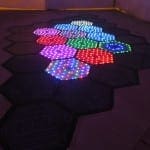Panels for Solar Roads Debut in North Idaho
 Courtesy of Solar Roadways
Courtesy of Solar Roadways
October 5, 2016 - 10:02 am
A startup company from North Idaho captivated donors and YouTube viewers worldwide a few years ago with its idea for turning roads and parking lots into solar farms. Now that far-out idea is available for public inspection for the first time. Go to Sandpoint, Idaho, and you can walk or ride across heavy-duty solar panels in a downtown square. There’s still a lot of skepticism that roads and walkways will ever do double duty as power plants on any grand scale. Correspondent Tom Banse went for a look.
Left: At night, small LED bulbs embedded in the Solar Roadways panels can be programmed to flash colorful patterns or display lane markings and signs. Photo courtesy of Solar Roadways.
The inspiration for the Solar Roadways company flowed from a married couple’s movie night. The flick was Al Gore’s global warming documentary, An Inconvenient Truth. In the audience were Julie Brusaw, a counselor, and her husband Scott, an electrical engineer. One other thing you need to know about Scott is that he never quite let go of an idea to scale up his childhood electric slot car track.
Scott Brusaw: “After watching Al Gore’s movie, Julie turned to me one day and said, ‘Couldn’t you make your electric roads out of solar panels?’ At first I just kind of laughed, blew it off and said, ‘You can’t even step on those things, let alone drive on them.’ So she’s dropped it.”
But he didn’t.
Scott Brusaw: “It stuck in my head. I started thinking about that and a week later I came back around. You know I said, ‘If we could figure out a way to protect the solar cells that just might work.’”
It took twelve years of research, refinement, fundraising and prototyping to get to the first public installation in the company’s hometown of Sandpoint. The unveiling ceremony took place twice because the tempered glass panels were literally half-baked (in an industrial oven) and not ready for the first scheduled reveal.
Despite the audible groans from the gathered crowd when the mayor announced the initial delay, the people who came to Jeff Jones Town Square on Friday seemed forgiving.
By end of the weekend, 30 hexagonal solar panels were embedded on a public plaza. They’re generating power and flashing colorful light patterns from little LED bulbs in the solar cells. In winter, the 150-square foot array can be set to warm the surface to clear snow and ice.
A wildly successful crowdfunding campaign in 2014 on Indiegogo and federal and state grants backed the company’s R&D. Julie says she’s glad to finally get the product in front of fans and skeptics.
Julie Brusaw: “This means so much to us. We’re devoting our lives to this. We’re exhausted. We’ve been working seven days per work trying to make it happen.”
The Brusaws have never ceased to evangelize about the opportunity to remake the road network into something intelligent, impervious to potholes and that generates clean energy.
“Our plan is to replace all asphalt and concrete,” said Scott Brusaw optimistically on Friday. “We did a calculation early on that there is over 28,000 square miles of asphalt and concrete surfaces exposed to the sun” just in the United States.
For that to happen, “It’s very important to get the cost down.” Julie Brusaw added.
Another frequently mentioned selling point is that the computer-controlled LED lights embedded in the Solar Roadways panels could be programmed to display lane markers or directional information, or notify drivers of upcoming hazards.
The owner of the Sandpoint West Athletic Club was in the crowd when the unveiling had to be delayed. Don Helander says he’s given thought to resurfacing with the solar road panels.
Don Helander: “We talked about our parking lot or a place out in the back of the facility where we would generate power for our club as well as having kind of a light up dance floor and activity center — that type of thing.”
The first demo project shows the Solar Roadways company has a real product, but a lot of doubts remain. Reasons to tap the brakes include questions about durability, practicality, cost competitiveness and solar efficiency. Engineering Services and Community Relations Manager Justin Holzgrove deals with solar contractors and customers at Mason County Public Utility District #3 in Western Washington. He applauds the Brusaws for “pushing the envelope,” but says it is “far-fetched” to believe the panels will become more than the occasional roadside attraction.
Justin Holzgrove: “If their goal is let’s shoot for the moon and push the limits of science and be dreamers, then that’s really exciting. But I don’t think we’re at a place where it can be considered a serious investment or technology practice unfortunately.”
Holzgrove said mass-produced rooftop solar panels make far more sense.
Justin Holzgrove: “Probably a lot cheaper, yeah. There’s no concern of cars driving on them and damage.”
The Brusaws responded that they don’t see themselves competing with rooftops.
The public funding to embed panels on just one small section of the Sandpoint town square totaled nearly $59,000. Solar Roadways has its next two demonstration projects lined up. There’s another small installation in a public plaza, this time in Baltimore. The project teed up after that is also not on an actual road. The solar panels will cover a section of sidewalk at a rest stop along historic Route 66 in Missouri.



